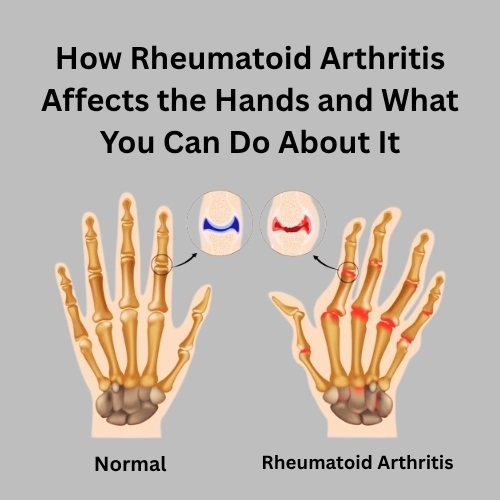Rheumatoid arthritis often begins subtly, but when it affects the hands, it can disrupt your ability to perform even the simplest daily tasks. Whether you’re brushing your teeth, typing on a keyboard, or gripping a cup, persistent joint pain or stiffness may signal something more serious. Recognising the early signs and understanding the condition’s impact on your hands can help you seek timely support and protect your mobility.
Why the Hands Are Commonly Affected
The small joints in the fingers and wrists are often among the first to be affected. This is because rheumatoid arthritis is an autoimmune condition that targets the synovial lining of joints — and the hands contain many of these joints. When the immune system mistakenly attacks healthy tissue, inflammation builds up and gradually damages cartilage, bone, and soft tissues.
Related Articles: How to Relieve Arthritis Pain in Hands Naturally and Effectively
If you’ve been wondering why you’re experiencing swelling, discomfort, or reduced grip strength, you’re not alone. Many people report these issues before receiving a diagnosis of rheumatoid arthritis in the hands.
Early Signs You Shouldn’t Ignore
Spotting early-stage rheumatoid arthritis in hands gives you the best chance of slowing progression and maintaining hand function. Look out for the following signs:
- Stiffness that lasts more than an hour in the morning
This is one of the most telling early indicators. You might find it difficult to bend or flex your fingers when you first wake up. - Swollen knuckles or wrist joints
Swelling tends to occur symmetrically, meaning both hands may show similar signs. - Pain with gripping or pinching
Tasks such as turning a key or opening a jar may become uncomfortable. - A warm sensation in the joints
Inflamed joints often feel warmer than surrounding areas due to increased blood flow.
Identifying these symptoms of rheumatoid arthritis in hands early allows for prompt evaluation and management by a rheumatologist.
Related Articles: Best Joint Supplements of 2025
How Rheumatoid Arthritis Progresses in the Hands
Over time, rheumatoid arthritis in the hands can lead to deformities if left untreated. Common complications include:
- Ulnar deviation
Fingers may start to bend towards the little finger, changing hand alignment. - Boutonnière and swan neck deformities
These are specific types of joint deformities that affect finger shape and movement. - Tendon rupture
Inflamed tissue can wear down tendons, leading to reduced hand strength and, in some cases, a complete loss of movement in specific fingers.
The impact is both physical and emotional, as these changes can make it difficult to carry out personal and professional responsibilities.
Related Articles: Arthritis Sufferers Swear by These 7 Supplements—Find Out Why
Diagnosing the Condition
If you suspect rheumatoid arthritis and hands are linked to your symptoms, see your GP or a specialist. Diagnosis involves a combination of:
- Blood tests
Markers such as rheumatoid factor (RF) and anti-CCP antibodies are often elevated. - Imaging
X-rays, ultrasound, or MRI can show joint damage and inflammation before visible symptoms appear. - Physical examination
A doctor will assess swelling, range of motion, and joint tenderness.
Living With Rheumatoid Arthritis in the Hands
Managing rheumatoid arthritis in hands effectively means focusing on a combination of lifestyle changes, medication, and in some cases, therapy or surgery. Here’s what can help:
Related Articles: Arthritis Relief Supplement: Soothe Aching Joints Naturally
- Medication
- Disease-modifying antirheumatic drugs (DMARDs)
These help slow progression and limit joint damage. - Biologics
These target specific parts of the immune system and are often used when standard treatments don’t provide relief. - NSAIDs and corticosteroids
These reduce inflammation and manage pain, though long-term use requires monitoring.
- Hand Exercises
Gentle hand stretches can help maintain flexibility and reduce stiffness. Common exercises include:
- Making a fist and then slowly opening your hand wide.
- Touching each fingertip to the thumb, one at a time.
- Using a soft ball or therapy putty to improve grip strength.
A hand therapist can tailor a routine based on your condition.
- Splints and Supports
Wearing wrist splints or finger supports can stabilise joints during flare-ups and reduce strain while performing tasks. These aids offer relief and prevent deformities when used consistently.
Related Articles: Cure Your Arthritis Naturally: 10 Proven Remedies That Work
- Heat and Cold Therapy
- Warm compresses can ease stiffness in the morning.
- Cold packs are more effective during flare-ups to reduce inflammation.
These simple therapies can make a noticeable difference in comfort and function.
Tips to Make Daily Life Easier
Adapting your environment and routine helps reduce strain on affected joints. Here are some practical suggestions:
- Use jar openers, button hooks, and wide-handled cutlery to minimise joint effort.
- Voice-to-text apps can reduce the need for typing if finger joints are painful.
- Organise your home so that frequently used items are easy to reach without excessive gripping or bending.
Creating a supportive environment goes a long way in preserving independence.
Related Article: Joint Support: Natural Joint Supplement for Arthritis Joint Relief Review
Protecting Your Hands at Work
Whether you work at a computer or in a hands-on profession, repetitive movements and prolonged stress on joints can worsen symptoms. Consider the following:
- Take frequent breaks to stretch and relax your fingers and wrists.
- Use ergonomic tools such as split keyboards, vertical mice, and cushioned pens.
- Speak to your employer about possible adjustments if you need support through occupational health.
This type of planning helps minimise flares and makes work more manageable.
When Surgery Becomes Necessary
For some, medication and lifestyle changes may not be enough. Surgery may be considered if:
- Pain becomes unmanageable
- Joint function significantly declines
- Deformities affect quality of life
Procedures may involve joint repair, tendon reconstruction, or in severe cases, joint replacement. Always discuss all options thoroughly with your healthcare team.
Emotional Impact and Support
Living with rheumatoid arthritis in the hands is about more than physical symptoms. The emotional effects — frustration, anxiety, or feeling isolated — deserve just as much attention. Talking therapies, peer support groups, and speaking openly with family can make a real difference.
You’re not weak for asking for help. In fact, doing so can improve your overall well-being and confidence in managing your health.
Prevention Isn’t Always Possible, But Early Action Helps
You can’t always prevent rheumatoid arthritis and hands from becoming affected, especially if you have a family history. But you can reduce the impact by recognising symptoms early and starting treatment before damage progresses. The earlier you act, the better your chance of preserving joint function and limiting pain.
Explore More About Related Conditions
If you’re interested in learning how to identify early signs and Joint Support Herbal Supplement for Arthritis to joint care, you can also read our article on hands with rheumatoid arthritis for further insight.
Final Thoughts
Hands are central to daily living. From simple gestures to essential tasks, they keep us independent. If you’re dealing with rheumatoid arthritis in the hands, taking prompt steps can help you stay in control of your health. Understand the condition, recognise the symptoms, and work closely with your healthcare provider to manage it effectively.




